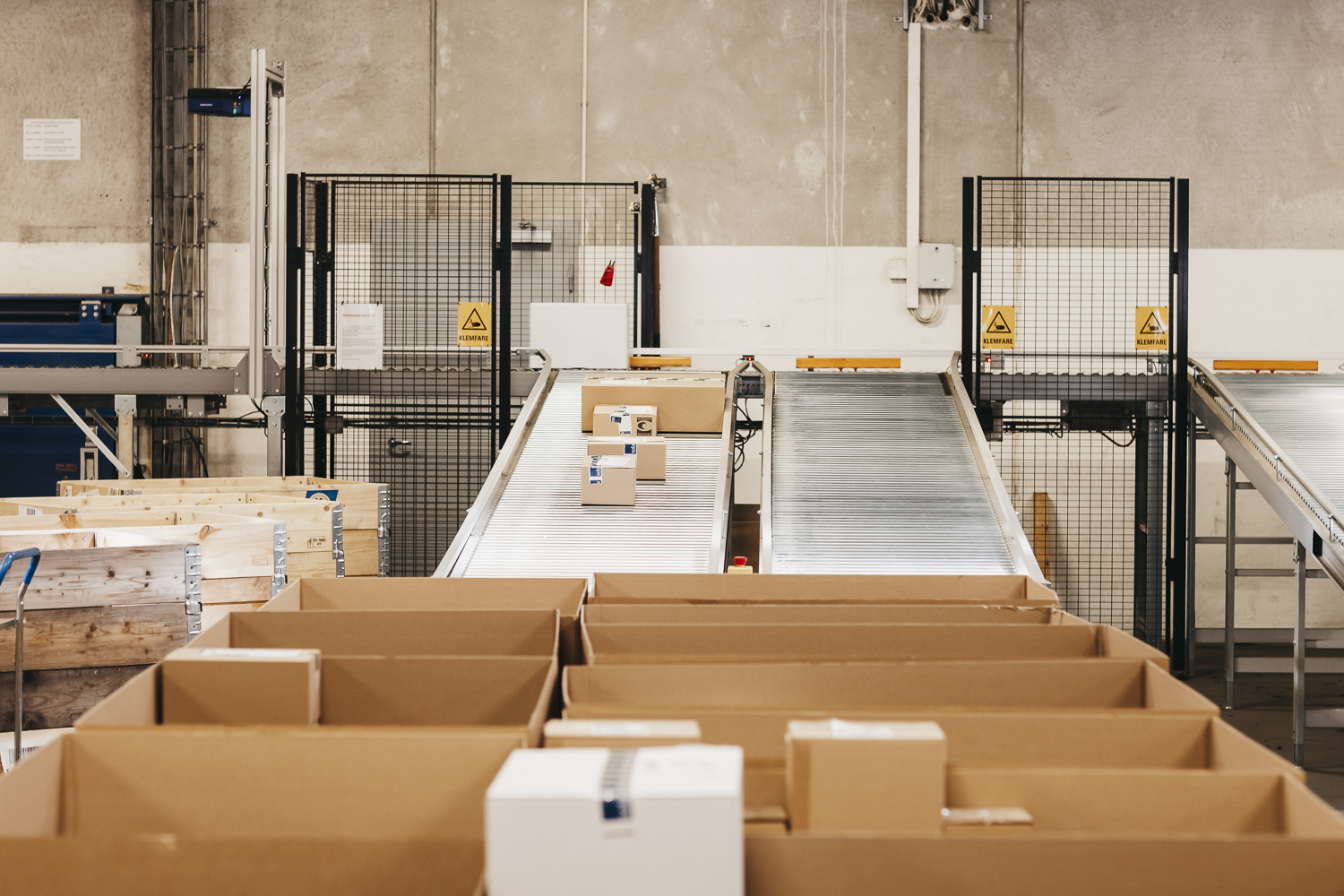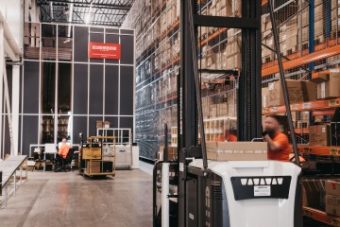10 trends shaping the warehouse of the future
The warehouse industry finds itself at an inflection point, driven by rapidly evolving consumer expectations, technological breakthroughs, and an ever-increasing need for operational and cost efficiency. In this dynamic landscape, businesses must stay ahead of the curve by embracing emerging trends that are fundamentally reshaping the warehouse of the future.

From cutting-edge automation and robotics to data-driven insights, sustainable practices, and innovative space optimisation strategies, these trends are revolutionising the way warehouses operate.
This blog post explores 10 key trends poised to transform the warehousing sector, empowering businesses to future-proof their operations and maintain a competitive edge.
1. Automated Storage and Retrieval Systems
Advanced Automated Storage and Retrieval Systems (AS/RS) such as AutoStore are the present and future of warehouse automation. This innovative, cube-based system leverages intelligent robots that effortlessly glide across an aluminium grid, storing and retrieving bins from a densely packed storage area. AutoStore’s modular design allows for unparalleled scalability and flexibility, making it an ideal solution for warehouses of all sizes, from compact micro fulfilment centres to vast distribution hubs.
By maximising vertical space utilisation and eliminating the need for aisles, AutoStore delivers unmatched storage density, enabling businesses to optimise their warehouse footprint while boosting efficiency and throughput.
This cutting-edge system can double or even quadruple storage capacity compared to traditional warehousing methods, minimising the need for costly expansions or new construction projects. Its modular nature also allows for seamless integration with other warehouse automation technologies like robotic piece picking solutions.
2. Robotic piece picking arms
Complementing advanced AS/RS solutions like AutoStore, robotic piece picking arms are revolutionising the order fulfilment process. These intelligent robotic arms, powered by machine learning algorithms and advanced vision systems, can accurately and efficiently pick and place a wide range of products with remarkable dexterity.
By automating this traditionally labour-intensive task, businesses can significantly reduce errors, improve productivity, and reallocate human resources to more value-added activities. Robotic piece picking arms can seamlessly integrate with AS/RS systems, creating a cohesive and highly efficient warehouse automation solution that streamlines the entire order fulfilment cycle, from storage to final packaging.
These robotic arms continuously learn and refine their picking capabilities through machine learning, adapting to changing product mixes and order patterns. This intelligent automation enables secure, accurate, and cost-effective order fulfilment while providing a rapid return on investment for businesses.
3. Data-driven warehouse software
In the warehouse of the future, data will be the driving force behind optimised operations. Sophisticated warehouse management systems (WMS) and data analytics tools will provide real-time insights into inventory levels, order patterns, and operational bottlenecks. By leveraging machine learning, artificial intelligence, and advanced algorithms, these data-driven solutions can accurately predict demand, optimise resource allocation, and streamline processes for maximum efficiency.
Moreover, predictive maintenance capabilities enabled by data analytics will minimise equipment downtime, further enhancing operational efficiency and reducing costly disruptions. Real-time tracking and visibility into asset locations, inventory levels, and process bottlenecks will facilitate proactive decision-making and expedite problem resolution, driving continuous improvement across the entire supply chain.
Data-driven warehouse software will also enable advanced capabilities like digital twin simulations, allowing businesses to virtually model and test various scenarios before implementing changes. This data-driven approach ensures well-informed decision-making and maximised warehouse performance.
4. Automation-as-a-Service
As warehouse automation becomes increasingly accessible to companies of all shapes and sizes, the Automation-as-a-Service (AaaS) model is gaining significant traction. This innovative approach allows businesses to implement advanced solutions like AS/RS and robotic piece picking arms without the need for substantial upfront capital investments. Through subscription-based or leasing models, companies can access cutting-edge technologies, enabling them to scale their operations as needed while minimising financial risks.
The AaaS model is particularly beneficial for small and medium-sized enterprises, providing a cost-effective path to automation and a competitive advantage in the market. By leveraging AaaS, businesses can future-proof their operations, adapt to changing demands, and stay ahead of the curve without being hindered by budgetary constraints.
For businesses with fluctuating or seasonal demand patterns, AaaS offers the flexibility to scale automation up or down as needed, ensuring optimal resource utilisation and avoiding costly over or under-provisioning of warehouse automation capabilities.
5. Micro fulfilment centres
The rise of e-commerce and the ever-increasing demand for faster delivery times have given birth to micro fulfilment centres (MFCs). These compact, localised warehouses are strategically located in urban areas, in close proximity to end consumers. MFCs enable businesses to streamline their last-mile delivery processes, reducing transportation costs and carbon emissions while meeting customer expectations for rapid fulfilment.
By leveraging advanced automation solutions like AutoStore and robotic piece picking arms, MFCs can efficiently handle high volumes of orders while minimising their physical footprint. Additionally, the implementation of data-driven inventory management and demand forecasting tools ensures optimal stock levels and rapid replenishment, further enhancing the agility and responsiveness of these localised fulfilment hubs.
MFCs are particularly valuable for businesses operating in the e-grocery, retail, and quick service restaurant industries, where speed and freshness are critical factors. Their localised nature enables businesses to provide a superior customer experience while optimising their supply chain operations.
Some MFCs are designed as “dark warehouses” or “dark stores”, where only staff members are permitted entry, and the entire fulfilment process is automated. These facilities can operate around the clock, leveraging lights-out automation and AI-driven systems to maximise efficiency and throughput without the need for human intervention in the warehouse environment itself.
Whether designed as a traditional MFC or a fully automated dark warehouse, these localised fulfilment centres are becoming increasingly crucial for businesses to meet the growing consumer demand for rapid and convenient delivery services in urban areas.
6. Autonomous vehicles
Autonomous vehicles, such as Autonomous Mobile Robots (AMRs) and Automated Guided Vehicles (AGVs), are transforming material handling within modern warehouses. These self-navigating robots can efficiently transport goods from one location to another, reducing the need for human intervention and increasing productivity.
AMRs, in particular, are highly flexible and can adapt to changing warehouse layouts, making them ideal for dynamic environments. Leveraging advanced sensors, machine vision, and intelligent navigation systems, AMRs can safely navigate warehouse aisles, working alongside human employees without the need for predefined routes or instructions.
As the warehouse of the future becomes increasingly automated, the integration of autonomous vehicles will play a crucial role in streamlining operations, optimising material flow, and enhancing overall efficiency. These robots can work in tandem with other automation solutions like AS/RS and robotic piece picking arms, creating a seamless and interconnected ecosystem for efficient intralogistics.
7. Sustainable warehousing
In the face of mounting environmental concerns and regulatory pressures, sustainability has become a top priority for businesses across industries, including warehousing. The sustainable warehouse of the future will prioritise eco-friendly practices, such as energy-efficient lighting, renewable energy sources like solar power, and comprehensive waste reduction and recycling initiatives.
Moreover, the implementation of space-optimising automation solutions like AutoStore can significantly reduce a warehouse’s carbon footprint by maximising storage density and minimising the need for expansions or new construction projects. By embracing sustainable practices, businesses can not only contribute to environmental conservation but also realise cost savings through improved energy efficiency and resource optimisation.
Leading companies are already implementing sustainable warehouse strategies, such as German outdoor retailer Bergfreunde, who reduced CO2 emissions per package by 30% after installing an AutoStore system. Their innovative solution eliminates aisles, requiring only 30% of the facility to be lit, significantly reducing power consumption and emissions.
8. Improving employee wellbeing
While automation is transforming warehouse operations, the human workforce remains an essential component. The warehouse of the future will prioritise employee wellbeing by implementing ergonomic workstations, promoting a healthy work-life balance, and providing opportunities for upskilling and career development.
Automated solutions like AutoStore and robotic piece picking arms can alleviate physically demanding and repetitive tasks, creating a safer and more comfortable working environment for employees. By reducing the risk of injuries and strain, businesses can minimise absenteeism and improve overall workforce satisfaction and retention.
Moreover, by automating mundane tasks, employees can be redeployed to more value-added roles that leverage their cognitive abilities and problem-solving skills. This not only enhances job satisfaction but also fosters a culture of continuous learning and professional growth within the organisation.
By fostering a positive and supportive workplace culture, businesses can attract and retain top talent, ultimately driving productivity, innovation, and long-term success in the competitive intralogistics industry.
9. Warehouse space optimisation
As real estate costs continue to rise and the demand for efficient operations grows, optimising warehouse space has become a critical priority. The warehouse of the future will leverage advanced technologies like AutoStore to maximise vertical space utilisation and eliminate the need for aisles, significantly increasing storage density.
By compactly stacking bins in a dense cube formation, AutoStore can deliver up to four times the storage capacity compared to traditional warehousing methods within the same footprint. This space optimisation not only reduces the need for costly expansions or relocations but also minimises the environmental impact associated with new construction projects.
Additionally, data-driven software and warehouse control systems will enable businesses to optimise their warehouse layouts, streamline material flow, and minimise wasted space, ensuring every square foot is utilised effectively and efficiently. Advanced analytics can identify bottlenecks, high-traffic areas, and opportunities for layout reconfiguration to maximise throughput and productivity.
For businesses operating in space-constrained urban areas or those experiencing rapid growth, optimising warehouse space is crucial for maintaining a competitive edge and meeting evolving customer demands without the need for disruptive and costly relocations.
10. AI in the warehouse
Artificial Intelligence (AI) will be pivotal to future warehouse technology, driving unprecedented levels of efficiency, optimisation, and intelligent decision-making. AI-powered systems will enable accurate demand forecasting, predictive maintenance, real-time inventory management, and seamless integration with warehouse automation solutions.
By leveraging machine learning algorithms and advanced analytics, AI systems can continuously analyse data, identify patterns, and provide valuable insights for process improvement and optimisation. These insights can be used to optimise order fulfilment processes, streamline material flow, and enhance overall supply chain performance.
Furthermore, the integration of AI with robotics and automation will enhance decision-making capabilities, enabling real-time adjustments and adaptations to changing conditions or unexpected events. AI-driven systems can continuously learn and refine their decision-making processes, ensuring that warehouse operations remain agile and responsive in an ever-evolving industry landscape.
As AI capabilities continue to advance, the warehouse of the future will increasingly rely on these intelligent systems to drive efficiency, accuracy, and intelligent automation across all aspects of intralogistics operations.
Conclusion
The warehouse of the future is being shaped by a convergence of technological advancements, evolving consumer demands, and the relentless pursuit of operational excellence. By embracing trends such as advanced automation, data-driven insights, micro fulfilment centres, autonomous vehicles, and AI, businesses can future-proof their operations and gain a competitive edge in the dynamic world of intralogistics.
However, it’s crucial to strike a balance between automation and human involvement, prioritising employee wellbeing, fostering a culture of continuous improvement, and promoting sustainable practices. As the intralogistics industry continues its transformative journey, those who adapt to these trends will be well-positioned to thrive in the era of the futuristic, highly optimised warehouse.
Want to build a future-ready warehouse operation with AutoStore? Get in touch with Element Logic’s experts today.
By Gavin Harrison, UK Sales Director, Element Logic



